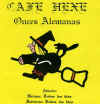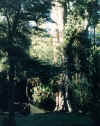I do want to see the Andes, close up and crossing them, and do that under
my own power: it is a quest not a wish. So, I head into the mountains towards Bariloche
along the major road and return via the road/ferry combination via the southern
route. 
From a post card: the Osorno volcano
I set out from Osorno, going east. The country reminds me of Bavaria, with its green meadows, cows and lakes. Farms are small here and milk cans wait out at the end of the driveway to be picked up by the collection truck every morning. Bramble bushes along the road are laden with fruit and I stop every so often to pick a handful or two to snack on. They are delicious, and these breaks forestall saddle soreness, the bane of the not so serious cyclist. Lago Puyhue (pronounced as poo-yeh-weh, a Mapuche word meaning "place of arrival") appears on the left, a large lake that reaches right to the foot of the mountains, and on the right horizon is the perfect cone of Volcan Osorno. The roads are good here: paved right up to the shoulder and if a spot is not in perfect condition, a sign apologizes for this shortcoming as you approach.
 Would you expect a museum here? What kind? An automobile museum, and top
notch! You gotta be kidding! But here it is: Automuseum MONCOPULLI, built by
Bernardo Eggers. He is a farmer, and the farm provides the funds for his creation. He says
he has to forsake other niceties of life, like a vacation, and he counts himself lucky
(actually he uses the word "smart") that his wife Ruth supports him. He started
in 1992, when he bought a white Studebaker and had it restored. The following two years
saw him add 6 more cars, and that's when he decided to build the museum. He added another
30 or so cars and trucks, mostly Studebakers as they were the cars of ordinary folks and
represented ideas ahead of their times. He shows not just the cars, but tools, parts (e.g.
steering linkage and door handles as they evolved over the years) and sales material
advertising these old cars in their days. He had inherited the house with his own
childhood collection of drawings (including his father's Studebaker truck) and the glossy
brochures of the cars that he managed to collect as a kid. It's what a museum ought to be:
a door into the past and I thought it was one of the most stimulating museums I ever
visited. In the foyer he exhibits a collection of photographic equipment, all relating to
his own career as an amateur artist, and two display panels with his own photos. I later
wished I could have taken some with me: they are images of nature and people and show a
cunning sense for abstraction. Oh, I should mention that he teaches photography to the
architectural students at the Osorno University. Drop by the museum if you get into this
neck of the woods: you won't regret it!
Would you expect a museum here? What kind? An automobile museum, and top
notch! You gotta be kidding! But here it is: Automuseum MONCOPULLI, built by
Bernardo Eggers. He is a farmer, and the farm provides the funds for his creation. He says
he has to forsake other niceties of life, like a vacation, and he counts himself lucky
(actually he uses the word "smart") that his wife Ruth supports him. He started
in 1992, when he bought a white Studebaker and had it restored. The following two years
saw him add 6 more cars, and that's when he decided to build the museum. He added another
30 or so cars and trucks, mostly Studebakers as they were the cars of ordinary folks and
represented ideas ahead of their times. He shows not just the cars, but tools, parts (e.g.
steering linkage and door handles as they evolved over the years) and sales material
advertising these old cars in their days. He had inherited the house with his own
childhood collection of drawings (including his father's Studebaker truck) and the glossy
brochures of the cars that he managed to collect as a kid. It's what a museum ought to be:
a door into the past and I thought it was one of the most stimulating museums I ever
visited. In the foyer he exhibits a collection of photographic equipment, all relating to
his own career as an amateur artist, and two display panels with his own photos. I later
wished I could have taken some with me: they are images of nature and people and show a
cunning sense for abstraction. Oh, I should mention that he teaches photography to the
architectural students at the Osorno University. Drop by the museum if you get into this
neck of the woods: you won't regret it!
 By the
way, there is another exceptional place in this area: on the road from Osorno, 15 minutes
on the way to Puerto Octay, there is a restaurant called "Hexe". There, I ate
the best cake of my life (Sorry, Mom, your cakes are good but the "Witch"s
tortes are out of this world). The owner, Giesela Hoelck, a perfectionist and seasoned
business woman, believes that we must not lose the old recipes. The restaurant only caters
to the "Once", the Chilenean equivalent to High Tea, where coffee is served with
various sandwiches and cakes, so anytime on the afternoon would be good for a visit. It's
not cheap but if you need a fix of good coffee and excellent cakes in an impecccable
atmosphere, drop by. It may be wise to book ahead as large family events can take up much
of the seating space. The phone number, from Osorno, is 231686.
By the
way, there is another exceptional place in this area: on the road from Osorno, 15 minutes
on the way to Puerto Octay, there is a restaurant called "Hexe". There, I ate
the best cake of my life (Sorry, Mom, your cakes are good but the "Witch"s
tortes are out of this world). The owner, Giesela Hoelck, a perfectionist and seasoned
business woman, believes that we must not lose the old recipes. The restaurant only caters
to the "Once", the Chilenean equivalent to High Tea, where coffee is served with
various sandwiches and cakes, so anytime on the afternoon would be good for a visit. It's
not cheap but if you need a fix of good coffee and excellent cakes in an impecccable
atmosphere, drop by. It may be wise to book ahead as large family events can take up much
of the seating space. The phone number, from Osorno, is 231686.
I cycle into the village of Entre Lagos and stop where the many buses
turn, have Congria (beef stew/soup) for lunch there, and then move further on towards the
mountains. The wind is from behind and soon I am in the foothills, the lake still to the
left, and across the water as well as to my right, rocky slopes rising from the forests.
Now, the road snakes towards a colossal building on the hill to the right: the Spa of Termas
de Puyehue. I am not interested in spending big money and pedal on, expecting a
hospedaje or smaller hotel to appear beside the road. But it's only farms and forests
because this road, serving a frontier with a historically hostile country, has been passed
over by development. The gradient gets steeper, the mountains close in and I can tell I am
getting closer to the border. I have cycled all day: it's pretty here, with forest on both
sides of the road, there are clear mountain streams and on the left looms a large volcano:
Puyehue. But I am tired and need
to camp soon. The relief comes unexpectedly: the Anticura campground of the Parque
Nacional de Puyehue is not on my map. I pitch the tent under a huge tree.
 This is my
base camp for the next five days.
This is my
base camp for the next five days.
Continuation of the Loop, click here:...
Back to Trip Overview
Back to Erhard's Home page